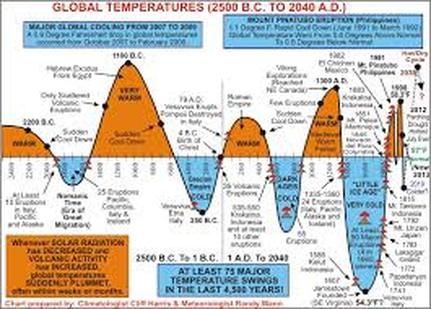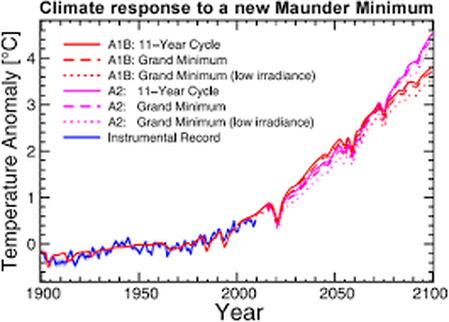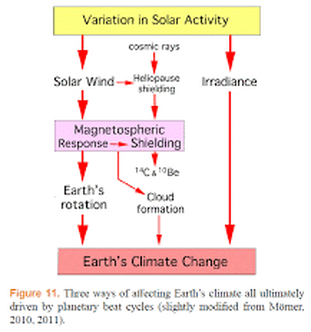GRANDE SOLAR MINIMUM - THE 'MINI' ICE AGE COMETH
RAPID GLOBAL COOLING FORECAST FOR 2017
by Kevin Long January 2014
www.thelongview.com.au
Understanding the details of the 18.6-year Lunar Declination Cycle is pivotal to understanding why the earth has been warming again since Feb 2012 and is predicted to rapidly cool again after 2016. This next drop in global temperature around 2017 will also be strongly influenced by the cooling effects of a rare solar minimum event known as the Bicentennial Solar Minimum Cycle which is predicted to impact the next three decades.The changing lunar orbit is the dominant reason why "global average temperatures" rapidly rise for about 5 years before a gradual decline sets in during the following 13 years. These repeating trends confuse most people who are involved in the climate change debate. This lunar influence is not appreciated or understood by most climate scientists or the IPCC and their partners in crime, the very biased mass media. I must acknowledge upfront that there are many other longer-term climate drivers that also contribute to the fluctuations in global temperature.
in this paper I will only focus on the 18.6 year Lunar Declination Cycle and the Bicentennial Solar Minimum Cycle.2015 WILL BE THE WARMEST YEAR BEFORE A DEEP CHILL SETS IN
Some of the largest and most rapid fluctuations in global average temperatures are brought about by the rapid swings our climate goes through when moving from a strong La Nina to a strong El Nino cycle. The 18.6-year Lunar Declination Cycle is the metronome behind these powerful anomalies that typically drive global temperature up by about 0.4°C within a five year period. A recent example of such a dramatic fluctuation was the rapid rise observed from 1992 to 1998 and then the general decline in average temperature until 2011.
Recently the warmer part of the lunar cycle has once again been driving global temperatures up towards another warm extreme (expected mid to late 2015). LUNAR MINIMUM STANDSTILL TO PRODUCE ANOTHER CLOSE-TO-RECORD WARM YEAR.Historically those warm surges in global temperature have occurred in the lead up years to the Lunar Minimum Standstill. February 1997 was the most recent Minimum Standstill. At the times of the Minimum Standstill, the moon only moves 18° north and south of the equator, in contrast to the much greater 28.5° movement that occurs during Maximum Standstill of 9.3 years before and after. The next Lunar Minimum Standstill occurs during October 2015.
Consequently during the four years leading up to this date, reducing amounts of equatorial heat will be moved to the polar regions. This is a direct result of the weaker “lunar air tides” not travelling as far south or north during this period. This will result in the accelerated growth of the “polar sea ice extent” which has alreadybeen occurring in the Antarctic during the last three years and for 18 months in the Arctic.
(See my website document: “The Lunar Air Tide Cycle Explained”)Consequently, during that same period (2012-2016), the sea surface heat will slowly build up in the equatorial regions - especially in the eastern Pacific where the El Nino anomalies develop. This extra heat concentration will minimise the development of any La Nina anomalies in the preceding two years (2013-14) before triggering the development of a warm and dry El Nino period during 2015. These standstill-enhanced El Nino years typically produce the fastest rise in global temperature, recording rises of up to 0.4°C above the preceding strongest La Nina-dominated years, which typically occur about 5 years prior. In the present cycle that cool wet La Nina event developed during 2010/11.
These strongest and coolest La Nina anomalies of the 18.6 lunar cycle typically develop in the fourth year after the previous Maximum Standstill which recently occurred in Sept 2006. The following La Nina anomaly during 2010 -11 was the wettest La Nina event for at least 160 years in Australia. That rare La Nina event caused eastern Australia’s climate to flip from a decade of severe drought to a 13-month period of record floods, before a quick return to dryer and warmer climate again during 2012-13. Under the influence of the approaching Minimum Standstill, 2014 and 2015 should continue the global warming trends of 2012-13 and reach an average global temperature close to that of 1998 (the warmest year on record as per most data sets).
However as soon as the next El Nino anomaly dissipates, during 2016 the most rapid global cooling trend for two centuries should become very obvious to all.
by Kevin Long January 2014
www.thelongview.com.au
Understanding the details of the 18.6-year Lunar Declination Cycle is pivotal to understanding why the earth has been warming again since Feb 2012 and is predicted to rapidly cool again after 2016. This next drop in global temperature around 2017 will also be strongly influenced by the cooling effects of a rare solar minimum event known as the Bicentennial Solar Minimum Cycle which is predicted to impact the next three decades.The changing lunar orbit is the dominant reason why "global average temperatures" rapidly rise for about 5 years before a gradual decline sets in during the following 13 years. These repeating trends confuse most people who are involved in the climate change debate. This lunar influence is not appreciated or understood by most climate scientists or the IPCC and their partners in crime, the very biased mass media. I must acknowledge upfront that there are many other longer-term climate drivers that also contribute to the fluctuations in global temperature.
in this paper I will only focus on the 18.6 year Lunar Declination Cycle and the Bicentennial Solar Minimum Cycle.2015 WILL BE THE WARMEST YEAR BEFORE A DEEP CHILL SETS IN
Some of the largest and most rapid fluctuations in global average temperatures are brought about by the rapid swings our climate goes through when moving from a strong La Nina to a strong El Nino cycle. The 18.6-year Lunar Declination Cycle is the metronome behind these powerful anomalies that typically drive global temperature up by about 0.4°C within a five year period. A recent example of such a dramatic fluctuation was the rapid rise observed from 1992 to 1998 and then the general decline in average temperature until 2011.
Recently the warmer part of the lunar cycle has once again been driving global temperatures up towards another warm extreme (expected mid to late 2015). LUNAR MINIMUM STANDSTILL TO PRODUCE ANOTHER CLOSE-TO-RECORD WARM YEAR.Historically those warm surges in global temperature have occurred in the lead up years to the Lunar Minimum Standstill. February 1997 was the most recent Minimum Standstill. At the times of the Minimum Standstill, the moon only moves 18° north and south of the equator, in contrast to the much greater 28.5° movement that occurs during Maximum Standstill of 9.3 years before and after. The next Lunar Minimum Standstill occurs during October 2015.
Consequently during the four years leading up to this date, reducing amounts of equatorial heat will be moved to the polar regions. This is a direct result of the weaker “lunar air tides” not travelling as far south or north during this period. This will result in the accelerated growth of the “polar sea ice extent” which has alreadybeen occurring in the Antarctic during the last three years and for 18 months in the Arctic.
(See my website document: “The Lunar Air Tide Cycle Explained”)Consequently, during that same period (2012-2016), the sea surface heat will slowly build up in the equatorial regions - especially in the eastern Pacific where the El Nino anomalies develop. This extra heat concentration will minimise the development of any La Nina anomalies in the preceding two years (2013-14) before triggering the development of a warm and dry El Nino period during 2015. These standstill-enhanced El Nino years typically produce the fastest rise in global temperature, recording rises of up to 0.4°C above the preceding strongest La Nina-dominated years, which typically occur about 5 years prior. In the present cycle that cool wet La Nina event developed during 2010/11.
These strongest and coolest La Nina anomalies of the 18.6 lunar cycle typically develop in the fourth year after the previous Maximum Standstill which recently occurred in Sept 2006. The following La Nina anomaly during 2010 -11 was the wettest La Nina event for at least 160 years in Australia. That rare La Nina event caused eastern Australia’s climate to flip from a decade of severe drought to a 13-month period of record floods, before a quick return to dryer and warmer climate again during 2012-13. Under the influence of the approaching Minimum Standstill, 2014 and 2015 should continue the global warming trends of 2012-13 and reach an average global temperature close to that of 1998 (the warmest year on record as per most data sets).
However as soon as the next El Nino anomaly dissipates, during 2016 the most rapid global cooling trend for two centuries should become very obvious to all.




